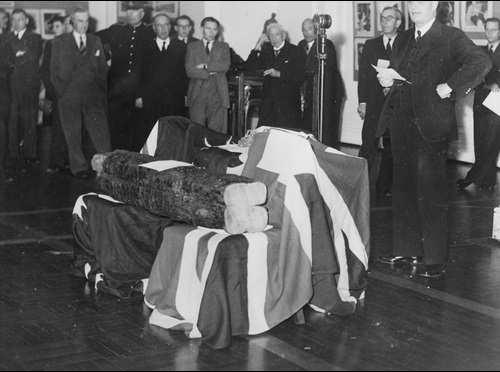Unknown maker, Shield of stained glass from the British House of Commons Library (detail), assembled c.1942, Official Gifts Collection, Parliament House Art Collection.
At the height of World War II, a 7-hour German bombing raid destroyed Britain’s House of Commons Chamber, and damaged Westminster Abbey and Buckingham Palace. Relics from the attack were donated to Australia in 1942 by the British Government for installation in Australian Parliament House.
"The relics will remain forever as evidence of what took place in the capital of the United Kingdom … that failed then, that has failed since, and cannot succeed in any circumstances.”
Prime Minister John Curtin, 7 October 1942
‘Blitzkreig’ – the lightening war – was the name coined for the devastating air-raids led by the Luftwaffe, or German Air Force, against the United Kingdom during the Second World War. More commonly known as ‘The Blitz’ the attack was a strategic bid to cause mass destruction and weaken morale.
Beginning 7 September 1940, London and surrounding cities were bombed daily in aerial attacks. More than 40,000 civilians lost their lives during the 8-month campaign. The final air-raid on London began the night of 10 May 1941. The bombing continued through the night and left much of the city in ruins.
In 1942 relics salvaged from the bomb-damaged Houses of Parliament, Buckingham Palace and Westminster Abbey were gifted to the Australian Government by the British Government. The gift was testimony to the shared heritage and steadfast bond between the two nations and intended to represent the central institutions of British public life then under wartime attack.
In October of the same year, Prime Minister John Curtin passed the relics into the care of the Speaker of the House of Representatives, Walter Nairn, in a ceremony in King’s Hall at Old Parliament House. During the ceremony Prime Minister Curtin gave an undertaking that the relics would be incorporated into the structure of the new Parliament House once built. They would be held in safe keeping until they could be displayed permanently, as promised, some 48 years later in the new home of the Australian Parliament.
"It is fitting that we should treasure these battle relics…,
for they remind us of our kinship in the past, our common aim
and purpose in the great struggle in which we are now engaged,
and of those great ideals which we are determined at all costs
to hand on to future generations."
Speaker of the House of Representatives Walter Nairn, 7 October 1942
These relics are reminders of the terrible cost of war, the power of courage and unity of purpose, and the strength of democracy in the face of adversity.
Timeline of events
• 1 September 1939: German forces invade Poland, and the Second World War begins.
• 7 September 1940: The London Blitz officially begins with the first of 57 nights of continuous bombing by the Luftwaffe.
• September 1940: Buckingham Palace is damaged by bombing.
• 10 May 1941: 700 tons of high explosives and thousands of incendiaries are dropped on London in the most devastating and final attack.
The Houses of Parliament are hit repeatedly, and the House of Commons Chamber is destroyed. The medieval wooden roof beams of Westminster Hall are set alight.
Over 50 Fire Service pumps and their crews struggle to contain huge blazes near Westminster Abbey. An incendiary bomb falls directly into the Lantern Tower of the Abbey, and the roof collapses in flames.

Unknown photographer, Blazing city building at the Height of a recent Blitz, c.1941,
Courtesy of the Australian War Memorial
•11 May 1941: The Luftwaffe withdraw to focus its efforts east and invade Russia. Although there are subsequent German bombings of London and surrounding cities until 1944 the targeted campaign known as the London Blitz has ended.
• 7 October 1942: In 1942 relics salvaged from the bomb-damaged Houses of Parliament, Buckingham Palace and Westminster Abbey were gifted to the Australian Government by the British Government. The gift was testimony to the shared heritage and steadfast bond between the two nations and intended to represent the central institutions of British public life then under wartime attack.
In October 1942, Prime Minister John Curtin passed the relics into the care of the Speaker of the House of Representatives, Walter Nairn, in a ceremony in King’s Hall at Old Parliament House. During the ceremony Prime Minister Curtin gave an undertaking that the relics would be incorporated into the structure of the new Parliament House once built.

D. McNEILL, Canberra, ACT. 7 October 1942. The Australian Prime Minister John Curtin giving a speech…, 1942,
courtesy of the Australian War Memorial
• 9 May 1988: New Parliament House is officially opened.
• 29 June 1990: New Parliament House opens a quiet space within the building for visitors and parliamentarians to contemplate the past life and future message of these relics.
• 10 May 2021: An expanded display is launched at Parliament House by the Presiding Officers to commemorate the 80th anniversary of the London Blitz.